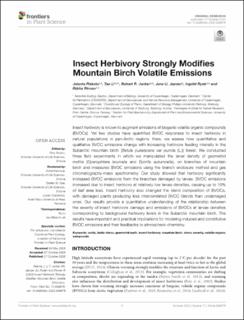Insect herbivory strongly modifies mountain birch volatile emissions
Peer reviewed, Journal article
Published version

Åpne
Permanent lenke
https://hdl.handle.net/11250/2686605Utgivelsesdato
2020Metadata
Vis full innførselSamlinger
- Publikasjoner fra CRIStin - NINA [2364]
- Scientific publications [1392]
Originalversjon
10.3389/fpls.2020.558979Sammendrag
Insect herbivory is known to augment emissions of biogenic volatile organic compounds (BVOCs). Yet few studies have quantified BVOC responses to insect herbivory in natural populations in pan-Arctic regions. Here, we assess how quantitative and qualitative BVOC emissions change with increasing herbivore feeding intensity in the Subarctic mountain birch (Betula pubescens var pumila (L.)) forest. We conducted three field experiments in which we manipulated the larval density of geometrid moths (Operophtera brumata and Epirrita autumnata), on branches of mountain birch and measured BVOC emissions using the branch enclosure method and gas chromatography-mass spectrometry. Our study showed that herbivory significantly increased BVOC emissions from the branches damaged by larvae. BVOC emissions increased due to insect herbivory at relatively low larvae densities, causing up to 10% of leaf area loss. Insect herbivory also changed the blend composition of BVOCs, with damaged plants producing less intercorrelated BVOC blends than undamaged ones. Our results provide a quantitative understanding of the relationship between the severity of insect herbivore damage and emissions of BVOCs at larvae densities corresponding to background herbivory levels in the Subarctic mountain birch. The results have important and practical implications for modeling induced and constitutive BVOC emissions and their feedbacks to atmospheric chemistry. arctic, biotic stress, geometrid moth, insect herbivory, mountain birch, stress severity, volatile organic compounds
